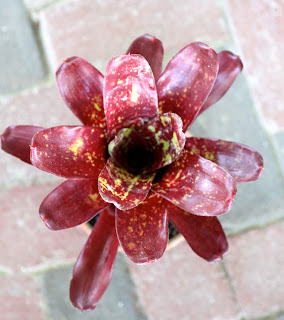As I promised in my last post, Dear Reader, today's essay is about our trip to the Rhinebeck Antiques Fair, held in Rhinebeck, New York, every Memorial Day weekend. First thing Saturday morning we piled in the Rover with our guests, Preston and Digby, and drove straight to the Dutchess County Fairgrounds, where the fair is held. Not one of us was in much of a spending mood, unless, of course, an inevitable "must have" appeared in one booth or another, and we approached the fair more for entertainment than as a buying opportunity.
 |
| Boy's "new" nineteenth-century English boxwood string dispenser |
But, of course, that didn't mean we weren't shopping, because—despite our best intentions—we were.
In a display case at the booth of Michael Haskins Antiques, of Palmyra, New York, Boy spotted a "must have" for his collection of string dispensers, a turned-wood example that complements two already sitting in Darlington's kitchen.
 |
| "Three little [nineteenth-century English turned-wood bee-skep-form] string holders are we!" |
One or two aisles before Boy found the string holder, I spied a large, early-nineteenth-century engraving in a lemon-yellow frame at the booth of John D. Gould Antiques. It was unceremoniously sitting on the floor, propped against the wall behind a small tiger maple stand. "What's that?" I asked. Boy chimed in, "Is it 'The Death of Montgomery . . . '?"
 |
| An engraving after a Trumbull painting that the artist painted for the purposes of having an engraving made. |
"No," John said, "it's 'The Battle of Bunker Hill.'" (Trumbull's painting, the source of the print, is generally known as "The Death of General Warren at the Battle of Bunker's Hill, June 17, 1775," so Boy wasn't so far off, simply confusing his generals on a muggy May morning.)
 |
| Trumbull's painting, profitably licensed for engraving by the artist, is in the collection of Boston's Museum of Fine Arts. Other Trumbull paintings of important scenes of the American Revolution, including a study for this canvas, are in the collection of the Yale University Art Gallery. Image courtesy of the Boston Museum of Fine Arts |
We will hang the print above an engraving of George Washington at the Battle of Trenton or Princeton (I cannot remember without abandoning my laptop and climbing the stairs) on the landing between the first and second floors of the front of Darlington House. Boy plans to tilt it forward with a few clean wine corks, hanging it in the old taste.
 |
| A perfect pair for tilting the top of a painting, print, or mirror. |
Our first purchase at the fair was the humblest: two old cast-iron irons, one sporting an anchor on its handle. Last weekend handyman Rich and his helper, Tony, carried out all of the wicker furniture, lamps, and other furnishings from the barn and the basement, and set up the screened porch. When we depart Darlington for the city in the summer, we push everything on the porch together and throw a big canvas tarp over the lot, weighing down the corners with old irons. Last Sunday afternoon, Boy suggested we find a few more of them (several were left behind in the house when we bought it) to better anchor the tarp against stormy winds. And so we now have a few more of them.
 |
| Anchors away? |
And that, Dear Reader, completes our Rhinebeck morning, done at Mach speed in under an hour!
Tell me, what did you find out and about in your travels this Memorial Day weekend?
Photographs, except where noted, by Boy Fenwick































.jpg)















































